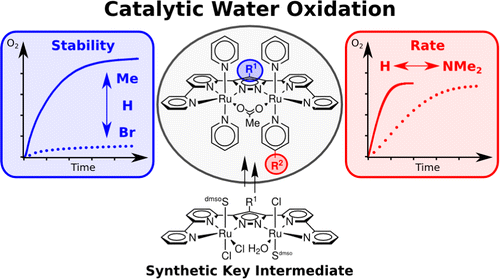A bis(bipyridyl)pyrazolate (Mebbp–) has recently been introduced as a rugged dinucleating, bis(tridentate) ligand for the formation of efficient diruthenium water oxidation catalysts (J. Am. Chem. Soc. 2014, 136, 24–27). Now, detailed protocols for the synthesis of a whole family of such dinuclear ruthenium complexes [{Ru(pyR2)2}2(μ-R1bbp)(X,Y)]2+ based on the bis(bipyridyl)pyrazolate scaffold are reported. The isolation of a synthetic key intermediate allowed the straightforward introduction of different pyridines as axial ligands. Thereby, a set of complexes with different substituents at the pyrazolate backbone (R1 = Br, H, Me), different pyridines as axial ligand (R2 = H, NMe2, SO3), and different (non)bridging units in the in,in-position (X,Y = Cl, H2O, OAc) has been prepared and thoroughly characterized. Complexes of the type [{Ru(pyR2)2}2(μ-R1bbp)(μ-OAc)]2+, with an exogenous acetato bridge, have been used as catalyst precursors in catalytic water oxidation experiments with a sacrificial oxidant. The effect of substitution on the pyrazole core of the R1bbp– ligand as well as on the pyridine ligands on both electrochemistry and catalytic activity has been systematically investigated. The catalyst stability, reflected by the turnover number, is crucially determined by the substituent at the pyrazolate ligand (R1 = Me > H > Br). In contrast, the axial pyridine ligands modulate the rate of the catalytic process, expressed by the initial turnover frequency (R2 = H > NMe2H+).
